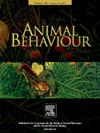Social attention increases object memory in adult but not younger great apes
IF 2.3
2区 生物学
Q2 BEHAVIORAL SCIENCES
引用次数: 0
Abstract
Research across primate species showed that social models (e.g. conspecifics) enhance memory (social memory effect, SME). In this preregistered study, we examined the ontogeny of the SME and its cognitive mechanism in great apes from infancy to adulthood (3 months–47 years), and explored both its persistence after a delay and its interaction with attentional measures of arousal (heart rate, HR). Forty-two individuals from four nonhuman great ape species viewed videos of social (hand) and nonsocial (mechanical claw) models constructing a tower, which was subsequently presented next to a novel tower. After 2 days, we showed the familiarized tower again next to a novel tower. Looking longer at the novel tower was interpreted as processing and recognizing the familiar tower (novelty response, NR). Results showed that adults (only) demonstrated higher NR for the tower built by the hand compared to the tower built by the claw when tested immediately, but not after a 2-day delay. We propose that this memory effect may have been driven by enhanced attention towards the social model, as adults demonstrated decreased HR relative to baseline in the social condition and accelerated HR in the nonsocial condition. However, we found no such differentiation in NR and HR in the younger individuals.
求助全文
约1分钟内获得全文
求助全文
来源期刊

Animal Behaviour
生物-动物学
CiteScore
4.60
自引率
8.00%
发文量
236
审稿时长
10.2 weeks
期刊介绍:
Growing interest in behavioural biology and the international reputation of Animal Behaviour prompted an expansion to monthly publication in 1989. Animal Behaviour continues to be the journal of choice for biologists, ethologists, psychologists, physiologists, and veterinarians with an interest in the subject.
 求助内容:
求助内容: 应助结果提醒方式:
应助结果提醒方式:


